
Shrimpfish, also called razorfish, are five small species of marine fishes in the subfamily Centriscinae of the family Centriscidae. The species in the genera Aeoliscus and Centriscus are found in relatively shallow tropical parts of the Indo-Pacific, while the banded bellowsfish, which often is placed in the subfamily Macroramphosinae instead, is restricted to deeper southern oceans.

The marbled parrotfish, also known as the seagrass parrotfish, is a species of marine ray-finned fish, a parrotfish from the family Scaridae and it is the only known member of the genus Leptoscarus. It has a wide Indo-Pacific distribution and is also found in the south eastern Atlantic Ocean. It is a coastal species found in beds of sea grass and seaweed.

Aeoliscus strigatus, also known as the razorfish, jointed razorfish or coral shrimpfish, is a member of the family Centriscidae of the order Syngnathiformes. This unique fish adopts a head-down tail-up position as an adaptation for hiding among sea urchin spines. The razorfish is found in coastal waters in the Indo-West Pacific. Its natural habitat includes beds of sea grass and coral reefs, where sea urchins are found.
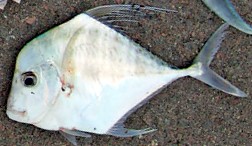
The Indian threadfish, also known as the Indian threadfin, diamond trevally, mirror fish or plumed trevally, is a large species of coastal marine fish of the jack family, Carangidae. The species is widespread in the waters of the tropical Indo-West Pacific Ocean, ranging from east Africa to India, Asia, Indonesia and Australia. Adult fish tend to inhabit coastal waters over reefs down to 100 m in depth, while juveniles inhabit a variety of environments including estuaries and seagrass beds. The Indian threadfish is similar to the other two species in the genus Alectis, with a slight concavity in the profile of the head the most obvious distinguishing feature. It is a large species, growing to 165 cm and 25 kg in weight. The species is carnivorous, consuming fishes, cephalopods and crustaceans. The Indian threadfish is of minor commercial importance, and has been the subject of aquaculture in Singapore.

The yellowspotted trevally, also known as the yellowspotted kingfish, goldspotted trevally or tarrum, is a widespread species of large inshore marine fish in the jack family Carangidae. The yellowspotted trevally inhabits the tropical and subtropical waters of the western Indo-Pacific region, from South Africa in the west to Japan and Australia in the east. The species is known to grow to a maximum length of at least 1.2 m, and is distinguished by gill raker and fin morphology, as well as the distinctive golden spots which give the fish its name. The yellowspotted trevally generally prefers inshore rocky and coral reefs, but is occasionally found over deep offshore sand banks to a depth of 100 m. It is a predatory fish, taking fish, cephalopods, and crustaceans, and shows diet partitioning with other trevallies in studies conducted in Australian waters. Reproduction is poorly studied, although observational evidence suggests spawning occurs in aggregations, probably during summer in South Africa. It is generally of minor importance to commercial fisheries throughout its range, but is considered an excellent sportfish by anglers and spearfishermen, and a good table fish.

The spiny seahorse, also referred to as the thorny seahorse, is a small marine fish in the family Syngnathidae, native to the Indo-Pacific area. It is classified as a Vulnerable species by the IUCN.
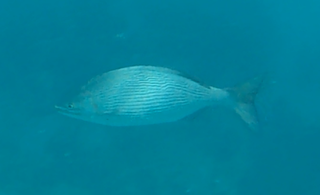
Kyphosus sectatrix, the Bermuda chub, Pacific drummer, beaked chub, grey drummer, Pacific chub or white chub, is a species of marine ray-finned fish, a sea chub from the family Kyphosidae. This species is found in tropical and subtropical coastal waters worldwide. It has had a confused taxonomic history dating back to Linnaeus's naming of the species in 1758.

Coastal fish, also called inshore fish or neritic fish, inhabit the sea between the shoreline and the edge of the continental shelf. Since the continental shelf is usually less than 200 metres deep, it follows that pelagic coastal fish are generally epipelagic fish, inhabiting the sunlit epipelagic zone. Coastal fish can be contrasted with oceanic fish or offshore fish, which inhabit the deep seas beyond the continental shelves.
Centriscus is a genus of shrimpfishes found in the Indian and Pacific Oceans.

The ring-backed pipefish is a species of pipefish found in the waters of the Indian Ocean off the southern coast of Australia. It occurs on reefs in beds of red and brown algae down to depths of 15 metres (49 ft). This species grows to a length of 22 centimetres (8.7 in) SL. This species is the only known member of its genus.

Taylor's garden-eel is a heteroconger belonging to the family Congridae. It is native to the central Indo-Pacific.

Aeoliscus punctulatus, also known as the speckled shrimpfish or jointed razorfish, is a member of the family Centriscidae of the order Syngnathiformes. This fish adopts a head-down, tail-up position as an adaptation for hiding among sea urchin spines. This fish is found in coastal waters in the Indo-West Pacific. Its natural habitat includes beds of seagrass and coral reefs, where sea urchins are found.
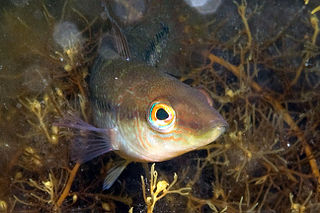
The little weed whiting is a species of ray-finned fish, a weed whiting from the family Odacidae which is endemic to Australia. It occurs along the Southern Australian coast, including Tasmania, ranging north to Cockburn Sound on the Indian Ocean side, and to north of the city of Sydney on the Pacific Ocean side. It inhabits marine and brackish waters, preferring sheltered areas such as estuaries and also on rocky reefs and in seagrass beds. It occurs at depths of from 1 to 22 metres. This species grows to a length of 14 centimetres (5.5 in) SL. It can also be found in the aquarium trade. This species is the only known member of its genus.
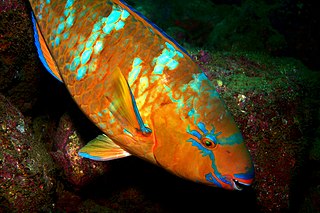
Scarus ghobban, also known as the blue-barred parrotfish, blue trim parrotfish, cream parrotfish, globe-headed parrotfish, green blotched parrotfish, yellow scale parrotfish, and bluechin parrotfish, is a species of marine ray-finned fish in the family Scaridae.

Neoniphon sammara, the sammara squirrelfish, also known as the blood-spot squirrelfish, slender squirrelfish, spotfin squirrelfish, armed squirrel-fish or javelin squirrelfish, is a species squirrelfish found in the Indian Ocean and Pacific Ocean from East Africa to the Hawaiian Islands. It feeds on shrimps and small crabs and fish at night and can grow up to 32.0 centimetres (12.6 in) TL in length, though its common length is only 23.0 centimetres (9.1 in) TL. Like N. opercularis, it has a venomous spine on its preopercle.
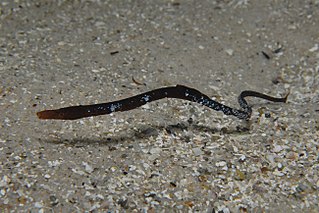
Histiogamphelus briggsii, also known as Brigg's pipefish, is a species of marine fish in the family Sygnathidae. It can be found in the shallow waters surrounding South Australia, New South Wales, and Northern Tasmania. Its habitat can consist of reefs, seagrass beds, and sandy beach and estuarine environments Individuals of this species can grow to lengths of 25 cm (9.8 in). They are an ovoviviparous species, in which males brood eggs and give birth to live young.

Histiogamphelus cristatus, known as Macleay's crested pipefish or rhino pipefish, is a species of marine fish belonging to the family Sygnathidae. This species can be found in a variety of marine habitats such as seagrass beds, sandy ocean bottoms, and estuaries, surrounding south and southwestern Australia. Their main source of food are small crustaceans found in the water column or in sediments. Males of the species brood eggs and give birth to live offspring.
Hypselognathus rostratus, also known as the knife-snouted pipefish is a species of marine fish belonging to the family Syngnathidae. This species can be found in very shallow coastal waters of southeastern Australia. Their habitat consists of sandy substrates, seagrass beds, and estuaries. Reproduction occurs through ovoviviparity in which the males brood eggs before giving live birth.

Trachyrhamphus bicoarctatus, also known as the double-ended pipefish is a species of marine fish belonging to the family Syngnathidae. They can be found in reefs, seagrass beds, and sandy habitats throughout the Indo-Pacific from East Africa to New Caledonia and from Japan to Australia. Males of this species are considered mature when they reach approximately 26 centimeters long, but adults can grow to be lengths of 40 centimeters. Reproduction occurs through ovoviviparity in which males brood eggs before giving live birth.

Cymolutes torquatus, the finescale razorfish, razor wrasse or collared knifefish, is a species of marine ray-finned fish from the family Labridae, the wrasses. It is a solitary wrasse of sandy flats which has a wide Indo-Pacific distribution. It has no recorded human uses.



















